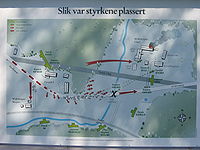Battle of Midtskogen
| Battle of Midtskogen | |||||||
|---|---|---|---|---|---|---|---|
| Part of Norwegian Campaign of the Second World War | |||||||
 Overview of the battle. Norwegian forces in green symbols. German forces in red symbols. |
|||||||
|
|||||||
| Belligerents | |||||||
|
|
|
||||||
| Commanders and leaders | |||||||
|
Olaf Helset Oliver Møystad |
Eberhard Spiller † | ||||||
| Strength | |||||||
| 100+ soldiers/militia, 2 Colt M/29 heavy machine guns |
100 paratroopers | ||||||
| Casualties and losses | |||||||
| 3 wounded | 2 killed, unknown number of wounded | ||||||
The Battle of Midtskogen was the battle fought on the night between 9 and 10 April 1940 during the Second World War between a German raiding party and an improvised Norwegian force. The site of the battle was Midtskogen farm, situated approximately 5 km (3.1 mi) west of the town Elverum at the mouth of the Østerdalen valley in southern Norway. The invading German troops were out on a raid to capture the Norwegian King, Haakon VII, and his cabinet and thereby forcing Norway into submission. After a short battle, the German force withdrew, having lost its commander in the fighting.
The Norwegian defenders mustered a slightly numerically superior force, the core of which was a rifle company of the Royal Guards and a number of hastily mustered volunteers, consisting mostly of members of local rifle clubs.
The German party consisted of approximately 100 Fallschirmjäger in a convoy of commandeered Norwegian civilian vehicles. Though somewhat numerically inferior the Germans were vastly superior in terms of training and firepower, possessing numerous modern submachine guns, light machine guns and hand grenades.
The opposing forces clashed at around 01:30 on 10 April with the German vehicles crashing into a Norwegian roadblock. The ensuing fire-fight continued until 03:00, ending with both forces pulling back. The Norwegians were reinforced and regrouped into new positions; the Germans, realizing their raid had failed, retreated to Oslo.
The casualties on both sides were light. The Germans suffered two men killed in action and an unknown number of wounded. One of the German fatalities was their military attaché Hauptmann Eberhard Spiller. Norwegian losses were three men wounded in action. The action may have been small, but as it prevented capture of the King and cabinet it probably saved Norway for the allied cause and proved a major boost to Norwegian morale, being very low due to the early German successes in the Norwegian Campaign.
...
Wikipedia
